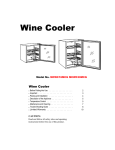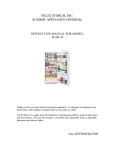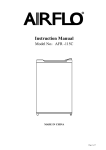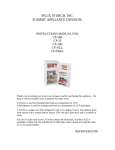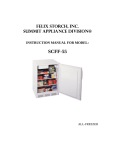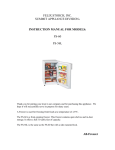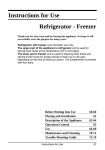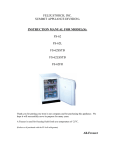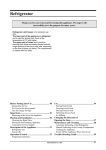Download Magic Chef MCWC16M User's Manual
Transcript
Wine Cooler Model No. MCWC16M MCWC30M Wine Cooler . . . . . Before Putting Into Use . . . . . . . . . . . . . . . . . Important . . . . . . . . . . . . . . . . . . . . . . . . Placing and Installation . . . . . . . . . . . . . . . . . Description of the Appliance . . . . . . . . . . . . . . . Operation Control . . . . . . . . . . . . . . . . . . . . . Maintenance and Cleaning . . . . . . . . . . . . . . . . . Trouble Shooting Guide . . . . . . . . . . . . . . . . . . Limited Warranty . . . . . . . . . . . . . . . . . CAUTION: Read and follow all safety rules and operating instructions before first use of this product. 2 3 4 5 5 6 7 8 9 10 Wine Cooler Thank you for buying this appliance. We hope it will successfully serve your requirements for many years. This appliance is intended for storing bottled wine in the temperature range of 5.5 to 19.0 / 41.9 o F to 66.2 o F SAVE THESE INSTRUCTIONS Before Putting Into Use . . . . . . . . . . . . . 2 Instructions for Use Tips for Energy Savings 3 Important . . . . . . . . . . . . . . . . . . . . . Disposing of Worn Out Appliances 4 Placing and Installation . . . . . . . . . . . . . Choosing the Right Place Placing the Self-standing Appliance Connection to Power Supply Description of the Appliance . . . . . . . . . . . . 5 5 Temperature Control . . . . . . . . . . . . . . Temperature Selection Illustration of the Appliance 6 Maintenance and Cleaning . . . . . . . . . . . . . 7 Automatic Defrosting of the appliance Cleaning of the Appliance Switch Off the Appliance When Not In Use Trouble-Shooting Guide . . . . . . . . . . . . . . . 8 9 Limited Warranty . . . . . . . . . . . . . . . . 1 10 Before Putting Into Use · If the gasket is damaged or the door seal is · Before connecting the appliance to electrical power supply, leave it to stand for about 2 hours, which will reduce the possibility of malfunctions in the cooling system due to transport handling. · Clean the appliance thoroughly, especially in the interior (See Cleaning and Maintenance). · In case the interior accessories are not correctly placed, rearrange them as described in chapter "Description of the Appliance" poor, energy consumption is substantially higher. To restore efficiency, replace the gasket. · Always consider instructions stated in sections Positioning and Energy Saving Tips, otherwise the energy consumption is substantially higher. · Remove shipping bracket at base of door opening and replace the foot before operating this appliance. Instructions for Use These instructions for use are intended for the user. They describe the appliance and correct operating procedures for safe use . SAVE THESE INSTRUCTIONS: Tips for Energy Saving · Try not to open the door too often, especially when the weather is hot and humid. Once you open the door , close it as soon as possible. This is especially important if you have an upright model . · Every now and then check if the appliance is sufficiently ventilated ( adequate air circulation behind the appliance ). · Set the thermostat from higher to lower settings as soon as possible (depends on how loaded the appliance is, ambient temperatures etc.). · Ice and frost layers increase energy consumption, so clean the appliance as soon as the frost layer is 3-5mm thick. 2 Important If you have bought this appliance to replace an old one equipped with a door lock that cannot be opened from the inside (lock, bolt), make sure that the lock is removed, disabled or destroyed before discarding. This will make it impossible for children to accidentally lock themselves inside the appliance and suffocate. The appliance must be properly connected to an electrical power supply. (See: Connection to Power Supply) . Do not use an extension cord. Always disconnect the appliance from the power supply before cleaning the appliance, or attempting repairs. WARNING: repairs should be performed by qualified service personnel only. Do not defrost the appliance with other electric appliances (for example a hair dryer) and never attempt to scrape/remove ice/frost with sharp objects. The cooling system of the appliance is filled with refrigerant and oil ,so when the appliance is damaged, handle it with care and dispose of it in compliance with environmental protection safeguards. The rating plate containing Model No/Serial No and other technical data specific to this unit, is located either inside the appliance or outside on the rear wall. · Disposing of Worn Out Appliances · DANGER OR WARNING: Risk of child entrapment. Before you throw away your old refrigerator or freezer: -Take off the doors - Leave the shelves in place so children may not easily climb inside. · The cooling system of the appliance is filled with refrigerant and insulating substances which should be separately treated and processed. Call your nearest authorised service agent. If you are unable to locate one, contact your local authorities or your distributor. Be careful not to damage the tubes on the rear wall of the appliance (danger of pollution). 3 Placing and Installation CHOOSING THE RIGHT PLACE WARNING Place the appliance in a dry and regularly ventilated room. Never place the appliance near heat emitting devices (e.g. cooking appliances, radiators, water heaters or similar devices) and do not expose to direct sunlight. Instructions to avoid to the risk of fire , electric shock , or injury to persons. The appliance should be positioned at least 2in. away from electric or gas cooking appliances and at least 12in. away from oil or coal fired stoves. If this is not possible, use an appropriate insulation barrier. For your personal safety, this appliance must be earthed. In the event of a malfunction or breakdown, earthing will reduce the risk of electric shock by providing a path of least resistance for electric current. This appliance is equipped with a power cord having an equipment earthing conductor and fused plug. The plug must be plugged into an appropriate wall outlet that is installed and wired in accordance with all existing local codes and ordinances. Consult a qualified electrician or serviceman if the wiring instruction are not clearly understood, or if doubt exists as to whether the appliance is properly earthed. WIRING INSTRUCTIONS Behind the appliance there should be a free space of at least 3in. . Kitchen units (cupboards) should be at least 2in. away from the appliance in order to assure adequate ventilation. There should be 4in. between both size of the chiller and other article. INSTALLATION CONNECTION TO POWER SUPPLY Place the appliance firmly on a solid base. Some appliances have adjustable feet on the front side; use them to level the appliance. Connect the appliance power cord and plug to a properly earthed wall outlet. The required nominal voltage and frequency are indicated on the rating plate (inside the unit or on the exterior rear wall of the unit). 4 Description of the appliance (A) Adjustable Wire Shelves (The number of shelves depends on the model) Shelves can be optionally placed on the guides inside the appliance. Perishable items should be stored towards the back/rear of the shelves. i.e. the coldest part of the shelf. (B) Defrost Water Outlet The interior of the appliance is cooled with a cooling plate mounted in the rear wall. Under the plate there is a channel and an outlet for defrost water. Regularly check the defrost water outlet and the drain channel for blockage. They should always be kept free and clean of particles. WE RESERVE THE RIGHT TO ALTER THE SPECIFICATIONS WITH NO EFFECT ON THE OPERATION OF THE APPLIANCE. Temperature Control The temperature of the appliance is controlled by setting the thermostat knob to a desired setting. Temperature Selection To turn the control to the "OFF" position, rotate the control knob to the "0" position. If the appliance has been left out of use for some time, set the control to maximum or the "7" position for 2-3 hours before turning to the desired position. If the appliance is not being used for long time periods, disconnect the plug and leave the door partially open. This will help to reduce mold/mildew from accumulating inside the appliance cabinet. To start the appliance turn the temperature control knob to the position corresponding to the desired cooling. Fig A (MCWC16M) see page 6 Fig B (MCWC30M) see page 6 The temperature will vary depending on the quantity of the item stored and on the frequency with which the door is opened. 5 CONTROL KNOB Fig A (MCWC16M) Fig B (MCWC30M) . Changes in ambient room temperature will affect the internal temperatures (choose correct setting of the thermostat knob). . In STOP (0) position the appliance does not operate (cooling system is switched off ), yet power supply is not interrupted. . Temperature in the appliance also depends on how often the door is opened. ILLUSTRATION OF THE APPLIANCE 1. THERMOSTAT DIAL: For controlling the temperature inside the wine cooler. Turns the motor on as soon as the temperature rises above the desired level. 2. PLASTIC COATED SHELVES: Odor resistant, rustproof, and removable for easy cleaning. 3. MAGNETIC GASKET: Tight fitting door seal keeps all the cooling power locked inside. No hooks or latches. 4. TEMPERED GLASS DOOR & INTERIOR LIGHT: Allows easy interior visibility. (Interior light for MCWC30M only) TEMPERATURE RANGE GUIDE: MIN. MED. MAX. Upper-Section 19.0 /66.2 F 17.0 /62.6 F 13.6 /56.4 F 0 0 0 Mid-Section 17.0 /62.6 F 14.0 /57.2 F 9.8 /49.6 F 0 0 0 The above temperatures may fluctuate between +/- 5 6 Lower-Section 14.0 /57.2 F 10.0 /50.0 F 5.5 /41.9 F 0 0 0 Maintenance and Cleaning Automatic Defrosting of the Appliance Switch Off the Appliance When Not In Use There is no need to defrost the chiller , because ice depositing on the inner back wall is defrosted automatically. Ice build-up on the inner back wall during the compressor operation will defrost automatically (when the compressor has cycled off) . Defrost water will drain out passing through the drain outlet in the inner back wall into a drain pan situated above the compressor, from where it evaporates. If you do not intend to use the appliance for long periods of time. Set the thermostat knob to the STOP (0) position, disconnect the power supply, take out the contents and defrost and clean the appliance. Leave the door slightly open. Cleaning the Appliance Disconnect the power supply before cleaning the appliance. Do not use coarse or aggressive cleaning agents as you may damage the surface. Clean the exterior with water and detergent. Remove the detachable accessories in the interior of the appliance and clean with water and liquid detergent. Plastic parts cannot be washed in dishwashers. Wash the interior of the appliance with lukewarm water , adding one or two spoonfuls of vinegar. After cleaning, connect the appliance to power supply and reload it. 7 Trouble-Shooting Guide . Sometimes you may come across minor problems Ice Formation on the Inner Rear Wall that in most cases do not require a service call and can be easily eliminated. The problem may have resulted from improper handing and / or installation of the appliance. Please refer to the below trouble-shooting guide to assist you in identifying the possible cause and solution to your problem. Should the problem still persist after completing these checkpoints. Contact the closest authorized service agent in your area for assistance. As long as the defrost water runs to the channel and through the outlet to the drain pan on the compressor, automatic defrosting of the appliance is assured. In case the ice formation on the inner back wall is increased (1/8-1/5in.), ice should be manually defrosted. Set the thermostat knob to STOP ( 0 ) position and leave the door open. Never use electric devices for defrosting and do not scrape the ice or frost layer with sharp objects. The Appliance Fails to Operate After Connecting to Electrical Power Supply After defrosting is complete, turn the knob to desired position and close the door. The cause of increased ice formation may be one of the following: _ the door does not seal well (clean the gasket if it is contaminated, or replace it if it is damaged); _ the door is frequently opened or left too long; _ the food stored in the appliance was warm; _ the food or dish is touching the inner back wall. . Check the power cord is properly connected. . Check the power supply in the electrical outlet. (blown fuse / circuit breaker) . . Make sure the appliance is switched on. (thermostat knob in operating position) Continuous Operation of the Cooling System . The door is frequently opened or left open for too long. . The door is not properly closed (the door may sag, the gasket may be polluted or damaged). . Perhaps you may have overloaded the appliance. . The reason may be inadequate ventilation of the compressor (assure adequate air circulation). 8 Check the accessories on the interior of the appliance, they should be placed correctly in their positions; also check, bottles, tins, and other vessels are not touching each other causing rattling and/or vibrations. Water is Leaking From the Appliance If the discharge water outlet is clogged, or the defrost water drips over the channel, water will leak from the appliance. . Clean the clogged outlet. . Manually defrost the increased ice layer ( see ice Formation on the Inner rear Wall ). Noise Cooling in this appliance is made possible by cooling the system using a compressor, which will produce certain noise levels. How noise noisy the appliance is depends on where it is placed, how it is used and how old the appliance is. . During the operation of the compressor the noise of the liquid is heard and when the compressor is not operating, the refrigerant flow is heard, This is a normal condition and it has no influence whatsoever on the lifetime of the appliance. . After starting the appliance, the operation of the compressor and the refrigerant flow may be louder, which does not mean that something is wrong with the appliance and it has no influence on the lifetime of the appliance. Gradually the noise will reduce. . Sometimes unusual and louder noise may be heard. This noise is often a consequence of inadequate installation. _ The appliance must be level and installed on a firm solid base/floor. _ The appliance should not touch the wall or kitchen units standing next to it. 9










